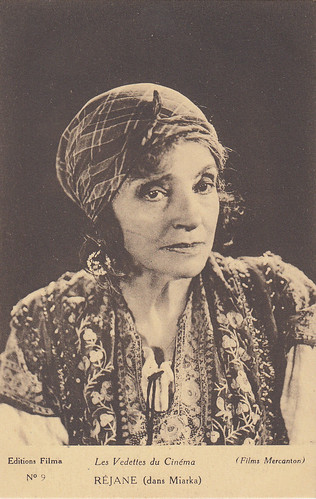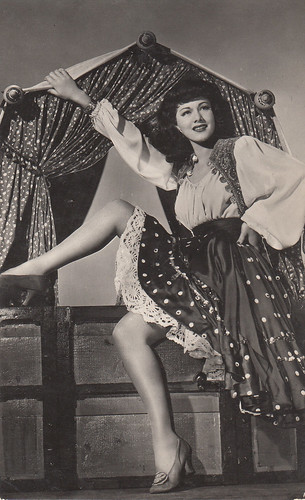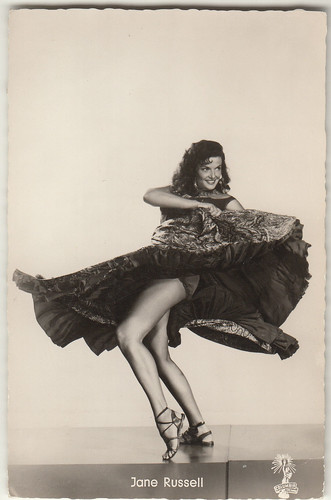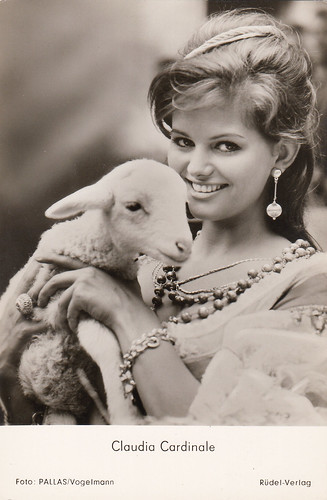Gypsies for one day
To our knowledge, Clara Bow, Dorothy Sebastian and Joan Blondell never played gypsies onscreen but studio photographers nevertheless thought it was a good idea to dress them as such.
Clara Bow

Spanish postcard by M.C. Barcelona, no. 61.
Dorothy Sebastian

German postcard by Ross Verlag, no. 4265/1, 1929-1930. Photo: MGM.
Joan Blondell

French postcard by Europe, no. 334. Photo: Warner Bros.
Playing gypsies onscreen
These actresses played gypsies in movies. For them, playing gypsy characters allowed them to wear outfits such as coloured skirts and blouses, scarves on the head and flashy necklaces, bracelets and earrings. The most unusual gypsy of this batch is probably German-born Marlene Dietrich. However, according to her daughter Maria Riva, Dietrich had great fun transforming herself into a gypsy, with dark make-up and a brunette wig.
Diana Karenne

Italian postcard by O.P.E.S. Torino. Diana Karenne in Passione tsigana/Gypsy Passion (Ernesto Maria Pasquali, 1916).
In Passione tsigana/Passione tzigana (1916), Diana Karenne plays Agora, a gypsy who falls in love with a gentleman from the city, Giulio, after a casual encounter during the nomadic life she leads with her tribe. But Mileko, head of the gypsies, who has set his eyes on Agora, threatens her to avenge himself against Giulio if she doesn’t give in to him. In order to protect the man she loves, she kills Mileko. Giulio instead thinks the delict has been committed out of jealousy between Agora and Mileko and so, he leaves her. When he gets to know the truth, it is too late. Agora has drunk the poison subtracted from the ring that Mileko wore. (Thanks to Ivo Blom for the information about this film).
Réjane

French postcard by Editions Filma in the Les vedettes du cinéma series, no. 9. Photo: Films Mercanton. Gabrielle Réjane in Miarka, la fille à l'ourse/Gypsy Passion (Louis Mercanton, 1920).
In Miarka, la fille à l’ourse, legendary French stage actress Réjane plays a gypsy matriarch called 'La Vougne'. She is the grandmother of Miarka, who falls in love with a non-gypsy young man, which is against her community rules.
Pola Negri

Italian postcard by Casa Editrice Ballerini & Fratini, Firenze, no. 38. Photo: Films Paramount, Roma. Pola Negri in The Spanish Dancer (Herbert Brenon, 1923).
In The Spanish Dancer (1923), Pola Negri plays Maritana, a gypsy dancer, who is in love with Don César, a penniless nobleman. After she saves César from the death penalty by pleading his case to Queen Isabel, Maritana and César marry. However, the King of Spain is attracted to the beautiful dancer. After several plot twists, all ends well and the King restores César’s estate to him.
Dolores Del Rio

Mexican postcard, no. 3234. Dolores Del Rio in Revenge (Edwin Carewe, 1928).
In Revenge (1928), Dolores Del Rio plays Rascha, a fiery gypsy. Smitten with her, Jorga, her father’s enemy, kidnaps her and sets to tame her. Needless to say, Rascha will finally fall in love with him.
Joan Crawford

French postcard by Europe, no. 501. Photo: MGM. Joan Crawford in Dream of Love (Fred Niblo, 1928).
In Dream of Love (1928), Joan Crawford plays Adrienne, a gypsy girl who meets Prince Mauritz. They fall in love but Mauritz leaves her, as he’s also involved in affairs with a duchess and a countess. Later, the young girl becomes a famous stage star as Adrienne Lecouvreur. She meets again Mauritz, who realizes that she’s her true love. In the end, Mauritz becomes King of his country. For the record, Adrienne Lecouvreur was a much-admired French stage star who was famous at the beginning of the 18th Century. But she was not a gypsy and her life has nothing to do with a Ruritanian romance such as Dream of Love.
Edith Jehanne

French postcard by J.R.P.R. Paris, no. 418. Photo: Robert Tomatis. Edith Jehanne in Tarakanova (Raymond Bernard, 1930).
In Tarakanova (1930), Edith Jehanne plays a gypsy called Tarakanova. She is the perfect look-alike of princess Dosithée, a hidden heiress to the Russian throne, who has been brought up in a convent and has no intention of leaving this peaceful place to fight for her rights. A plotter, Count Chouvaloff, persuades Tarakanova that she is Dosithée and that she is destined to ascend the imperial throne. But Empress Catherine II of Russia doesn’t see things that way and it will end in tragedy for the young woman.
Katharine Hepburn

German postcard by Ross Verlag, no. 8972/1, 1933-1934. Photo: RKO Radio. Katharine Hepburn in The Little Minister (Richard Wallace, 1934).
In The Little Minister (1934), Katharine Hepburn plays a feisty gypsy called Babbie, who meets a new young minister, Gavin Dishart, who has just arrived in the poor village of Thrums, in Scotland, in 1840. At first wary of her, he gradually falls in love. His parishioners, who came to like and respect him, are unhappy about their romantic liaison. They start to question Gavin’s legitimacy and, increasingly alarmed by his behaviour, end by voting to dismiss him. In the course of the story, it is revealed that Babbie is in fact Lady Babbie, a ward of Lord Rintoul, whom he plans to marry. According to the American Film Institute’s film plot summary, Rintoul has found her as a little girl, abandoned by her gypsy tribe, and has reared her. Babbie has taken the habit of regularly leaving Rintoul’s estate, dressed and acting as a gypsy, incognito. In the end, after many twists, Thrums inhabitants come to respect Gavin’s choice and realize that Babbie is the right woman for him. Rintoul also accepts that she marries Gavin.
Maria Montez

Spanish postcard no. 3140. Maria Montez in Gypsy Wildcat (Roy William Neill, 1944).
In Gypsy Wildcat (1944), Maria Montez is Carla, a gypsy dancer, who has been abandoned as a child and has been adopted by tribe leader Anube. She falls in love with a handsome stranger called 'Michael'. It is later revealed that she is in fact the daughter of a countess and is heiress to her family’s castle. Evil Baron Tovar plans to marry her to gain ownership of the property. Carla will be rescued in the end and she and Michael can take control of the castle.
Marlene Dietrich

Spanish card by I.P. y papeleria Machi Benifayo. Photo: Paramount. Marlene Dietrich and Ray Milland in Golden Earrings (Mitchell Leisen, 1947). Spanish title: En las rayas de la mano.
In Golden Earrings (1947), Marlene Dietrich plays a gypsy called Lydia. She helps British Intelligence Service officer Ralph Denistoun who, just before the outbreak of World War II, has been sent to Nazi Germany to find a special poison gas formula. After Denistoun has successfully achieved his secret mission, largely thanks to Lydia, he returns to England. Lydia and Denistoun, who had fallen in love, will be reunited after the end of the War.
Jane Russell

German postcard by Kolibri-Verlag, Minden/Westf., no. 2225. Photo: Columbia Pictures. Jane Russell in Hot Blood (Nicholas Ray, 1956).
In Hot Blood (1956), Jane Russell plays Annie Caldash, an American gypsy. The king of gypsies arranges a marriage for his brother Stephano to Annie. Stephano, who has distanced himself from his clan, is reluctant, as he’s already involved in an affair with another woman. However, Annie succeeds to marry him by coming up with a scheme. An angry Stephano leaves but soon begins to miss Annie. Stefano will finally come to terms with his gypsy roots and will agree to become king of gypsies at his brother’s death, with Annie on his side.
Claudia Cardinale

German postcard by Rüdel Verlag, no. 3561. Photo: PALLAS / Vogelmann. Claudia Cardinale in Cartouche (Philippe de Broca, 1962).
In Cartouche (1962), Claudia Cardinale plays Vénus, a gypsy who is big-hearted highwayman Cartouche’s girlfriend. He soon becomes infatuated with aristocratic Isabelle de Ferrusac and neglects Vénus. He is captured by the police but is saved by its fellow companions, leaded by Vénus, who is killed during the fight by saving her beloved’s life.
If you want more, you can click here to view my previous post on Carmen, one of the most famous gypsy characters in popular history.
Real gypsies
This section is devoted to two female performers who were born into the gypsy community. Two very interesting ladies, who always stayed proud of their gypsy roots.
Tela Tchaï

German postcard by Ross Verlag, no. 137/2. Photo: Nero / Vereinigte Star-Film. Téla Tchaï in Die Herrin von Atlantis/L’Atlantide/Queen of Atlantis (G.W. Pabst, 1932).
Tela Tchaï was born in 1909 in Roubaix, in the North of France. Orphaned at age 8, she had to enter a third-rate itinerant circus, where she performed as a dancer and as an equestrienne. She was mistreated and tried to escape several times. She finally succeeded in 1924 and found refuge with a couple of peasants, with whom she stayed until 1926. She then joined a troupe of travelling comedians.
In 1928, she was in Paris and soon began to model for famous painters such as André Derain. In 1931, she danced at the International Colonial Exhibition and was noticed by film director G.W. Pabst, who gave her the part of Brigitte Helm’s handmaid Tanit-Zerga in L’Atlantide/Die Herrin von Atlantis (1932).
She then had leading roles in Gitanes (1932) and Roi de Camargue (1935), in both of which she played gypsies. She also appeared in Friedrich Feher’s La symphonie des brigands/The Robber’s Symphony (1936) and played exotic Sultana in a Red Sea adventure film, Les secrets de la Mer Rouge (1937). At the end of the 1930s, she was signed to play in Christian-Jaque’s Tourelle 3 but, due to the beginning of World War II, it was never completed.
After small roles in Les mystères de Paris (1943) and Farandole (1945), she decided to turn to painting. She was probably the first female painter to come from the gypsy community. Her work brought her good notices and was exhibited in places such as Paris and Lausanne. True to the spirit of independence and freedom that had guided her through her life, Tela Tchaï never married and never had any children. She passed away in 1993.
Carmen Amaya

Vintage autographed card. Carmen Amaya.
Carmen Amaya was born in Barcelona, Spain, in a family of Catalan gypsies. Her year of birth has been the subject of speculation. Several sources give 1913 but recent research shows that the year is most probably 1918. At an early age, she began to accompany her father, a guitarist, in Barcelona streets and cafés and danced to his music. It seems that she made her official stage debut in her native city in 1924, at the Teatro Espanol.
At the end of the 1920s, she started to be noticed and earned the nickname of 'La Capitana'. In 1929, she appeared in a revue in Paris and danced in front of King Alfonso XIII at the Barcelona World Fair. That same year, she made her film debut, alongside her aunt and her cousin, in Benito Perojo’s French-Spanish co-production La Bodega, starring Conchita Piquer.
Year after year, her popularity steadily increased and she won great recognition when she performed in 1935 at the Madrid Coliseum. In the cinema, she made another brief appearance, alongside her father and her aunt, in Dos mujeres y un Don Juan (1933) and had a good opportunity to shine in La hija de Juan Simon (1935), in which her dancing scene on a table especially stood out.
She then was featured in the short Don Viudo de Rodriguez (1936), with comedians Alady and Lepe, and starred in the title role of Maria de la O (1936). In 1937, she decided to flee from the civil war and left for Latin America, where she successfully toured many countries and became widely admired. In 1939, she starred in the Cuban short El embrujo del Fandango. At the beginning of 1941, she started to perform in the U.S.A. and was a hit. Famous impresario Sol Hurok commissioned the short Original Gypsy Dances (1941) to showcase her dancing skills. In 1942, she played the Carnegie Hall. She also danced in the Hollywood musicals Knickerboxer Holiday (1944), Follow the Boys (1944) and See My Lawyer (1945).
In 1945, she starred in a Mexican movie, Los amores de un torero. In 1947, she made her comeback in Spain. From then on, she continued to tour in her native country and internationally. Her film career continued in France with Quand te tues-tu? (1953), in Argentina with Dringue, Castrito y la lampera di Aladino (1954) and in Mexico with Musica en la noche (1958). She had her last starring role as a gypsy mother in the Spanish-made Los Tarantos (1963), which was nominated for an Oscar in the Best Foreign Film category but lost to Fellini’s 8 1/2.
The lady who is considered by many as the most mythical and influential flamenco dancer of all time passed away in 1963. In Barcelona, two monuments can be found in her honour: a fountain in Barceloneta and a statue in the Joan Brossa Gardens in Montjuic. Another statue has been erected in Begur, the city where she died.
Text and postcards: Marlene Pilaete.
No comments:
Post a Comment